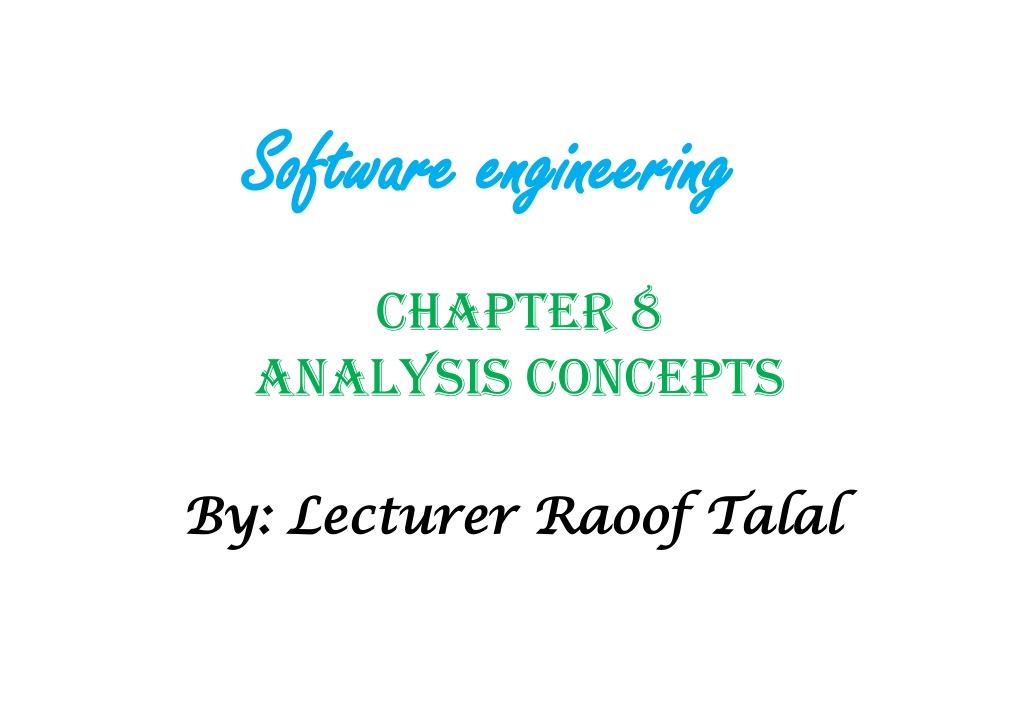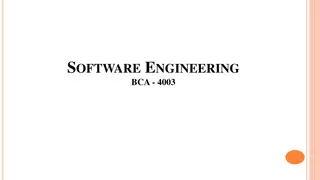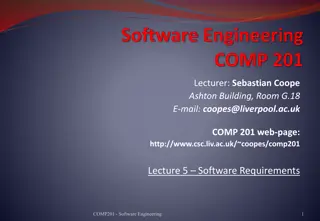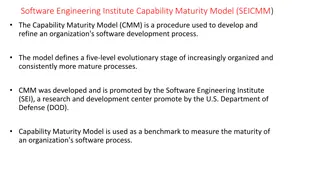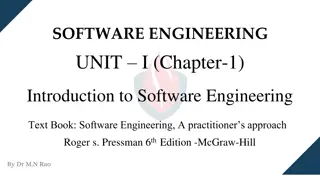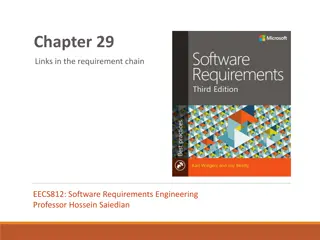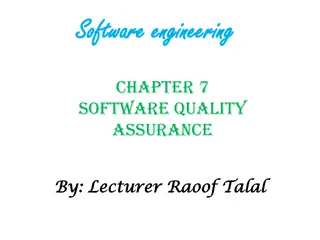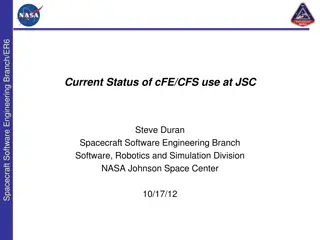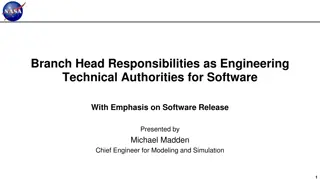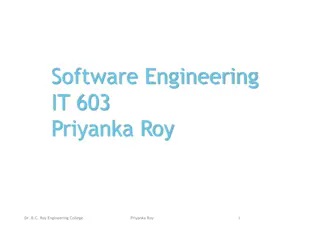Understanding Requirements Analysis in Software Engineering
Requirements analysis is a crucial task in software engineering that bridges the gap between system engineering and software design. It involves specifying software's operational characteristics, interface with other system elements, and constraints it must meet. Through elicitation processes like meetings and interviews, software engineers refine software allocation and build models of data, functional, and behavioral domains to meet customer needs effectively.
Download Presentation

Please find below an Image/Link to download the presentation.
The content on the website is provided AS IS for your information and personal use only. It may not be sold, licensed, or shared on other websites without obtaining consent from the author. Download presentation by click this link. If you encounter any issues during the download, it is possible that the publisher has removed the file from their server.
E N D
Presentation Transcript
Software engineering Software engineering Chapter 8 Analysis concepts By: Lecturer By: Lecturer Raoof Raoof Talal Talal
8.1 RequirementsAnalysis Requirements analysis is a software engineering task that bridges the gap between system engineering and software design (Figure 8.1). Requirements engineering activities result in the specification of software s operational characteristics (function, data, and behavior), indicate software's interface with other system elements, and establish constraints that software must meet.
Requirements analysis allows the software engineer (sometimes called analyst in this role) to refine the software allocation and build models of the data, functional, and behavioral domains that will be treated by software. Finally, the requirements specification provides the developer and the customer with the means to assess quality once software is built.
8.2 Requirements Elicitation for Software Before requirements can be analyzed, modeled, or specified they must be gathered through an elicitation process (extraction). A customer has a problem that may be subject to a computer-based solution. A developer responds to the customer's request for help.
8.2.1 Initiating the Process The most commonly used requirements elicitation technique is to conduct a meeting or interview. Neither person knows what to say or ask; both are thinking about where it might lead; but at the same time, both want it to be a success.
The analyst starts by asking context-free questions. The first set of context-free questions focuses on the customer, the overall goals, and the benefits. For example, the analyst might ask: Who is behind the request for this work? Who will use the solution? What will be the economic benefit of a successful solution?
The next set of questions enables the analyst to gain a better understanding of the problem and the customer to voice his or her perceptions about a solution: How would you characterize "good" output that would be generated by a successful solution? What problem(s) will this solution address? Can you show me (or describe) the environment in which the solution will be used? Will special performance issues or constraints affect the way the solution is approached?
The final set of questions focuses on the effectiveness of the meeting. The following (abbreviated) list suggested: Are you the right person to answer these questions? Are your answers "official"? Are my questions relevant to the problem that you have? Am I asking too many questions? Can anyone else provide additional information? Should I be asking you anything else?
8.2.2 Facilitated Application Specification Techniques Too often, customers and software engineers rather than working as a team to identify and refine requirements, each defines its own "territory"(ground) and communicates through a series of formal position papers, documents, and question and answer sessions. History has shown that this approach doesn't work very well.
A team-oriented approach has been developed to requirements gathering that is applied during early stages of analysis and specification, Called facilitated application specification techniques (FAST), this approach encourages the creation of a joint team of customers and developers who work together.
8.2.3 Quality Function Deployment Quality function deployment (QFD) is a quality management technique that translates the needs of the customer into technical requirements for software. Originally developed in Japan in the early 1970s, QFD emphasizes an understanding of what is valuable to the customer and then deploys these values throughout the engineering process. QFD identifies three types of requirements
1- Normal requirements: The objectives and goals that are stated for a product or system during meetings with the customer. Examples of normal requirements might be requested types of graphical displays, and specific system functions.
2- Expected requirements: These requirements are implicit to the product or system and may be so fundamental that the customer does not explicitly state them. Examples of expected requirements are: ease of human/machine interaction, correctness and reliability, and ease of software installation.
3- Exciting requirements: These features go beyond the customer s expectations and prove to be very satisfying when present. For example, word processing software is requested with standard features. The delivered product contains a number of page layout capabilities that are quite pleasing and unexpected.
8.3 Software Prototyping Analysis should be conducted regardless of the software engineering paradigm that is applied. However, the form that analysis takes will vary: In some cases it is possible to apply operational analysis principles and derive a model of software from which a design can be developed, In other situations, requirements elicitation (via FAST, QFD, use- cases, or other techniques) is conducted, analysis principles are applied,
and a modelof the software to be built, calleda prototype, is constructed for customer and developer assessment. For software prototyping to be effective, a prototype must be developed rapidly so that the customer may assess results and recommend changes. To conduct rapid prototyping, three generic classes of methods and tools are available:
1- Fourth generation techniques: Fourth generation techniques (4GT) encompass a broad array of database query and reporting languages, program and application generators, and other very high-level nonprocedural languages. 2- Reusable software components: Another approach to rapid prototyping is to assemble, rather than build, the prototype by using a set of existing software components.
Prototyping and program component reuse will work only if a library system is developed so that components that do exist can be cataloged and then retrieved. 3- Formal specification and prototyping environments: Over the past two decades, a number of formal specification languages and tools have been developed as a replacement for natural language specification techniques.
8.4 Specification The Software Requirements Specification is produced at the analysis task. The formats of software requirements specifications include: The Introduction: states the goals and objectives of the software, describing it in the context of the computer based system. Actually, the Introduction may be nothing more than the software scope of the planning document.
The Information Description: provides a detailed description of the problem that the software must solve. Information content, flow, structure, Hardware, software, and human interfaces are described. Functional Description: A description of each function required to solve the problem is presented here.
The Behavioral Description section: examines the operation of the software as a consequence of external events and internally generated control characteristics.
Validation Criteria: is probably the most important, the most often neglected section of the Software Requirements Specification. How do we recognize a successful implementation? What classes of tests must be conducted to validate function, performance, and constraints? We neglect this section because completing it requires a thorough understanding of software requirements.
Bibliography and Appendix: The bibliography contains references to all documents that relate to the software. These include other software engineering documentation, technical references, vendor literature, and standards. The appendix contains information that supplements the specifications. Tabular data, detailed description of algorithms, charts, graphs, and other material are presented as appendixes.
A review of the Software Requirements Specification (and /or prototype) is conducted by both the software developer and the customer. Once the review is complete, the Software Requirements Specification is "signed off" by both the customer and the developer.
Requests for changes in requirements after the specification is finalized will not be eliminated. But the customer should note that the change is an extension of software scope and therefore can increase cost and/or extend the schedule.
8.5 Analysis Modeling At a technical level, software engineering begins with a series of modeling tasks that lead to a complete specification of requirements and a comprehensive design representation for the software to be built. Over the years many methods have been proposed for analysis modeling. However, two now dominate. The first, structured analysis is a classical modeling method. The other approach, object oriented analysis.
8.6 Data Modeling Data modeling methods make use of the entity relationship diagram. The ERD enables a software engineer to identify data objects and their relationships using a graphical notation.
8.6.1 Data Objects, Attributes, and Relationships The data model consists of three interrelated pieces of information: the data object, the attributes that describe the data object, and the relationships that connect data objects to one another. Figure 8.2
